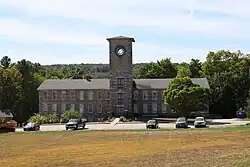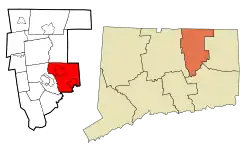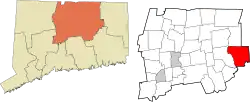Mansfield, Connecticut
Mansfield is a town in Tolland County, Connecticut, United States. The town is part of the Capitol Planning Region. The population was 25,892 at the 2020 census.[2]
Mansfield | |
|---|---|
| Town of Mansfield | |
 Kirby's Mill, in the Mansfield Hollow part of town | |
 Seal | |
  | |
| Coordinates: 41°47′18″N 72°13′44″W | |
| Country | |
| U.S. state | |
| County | Tolland |
| Region | Capitol Region |
| Incorporated | 1702 |
| Government | |
| • Type | Council-Manager |
| • Town Manager | Ryan Aylesworth |
| • Mayor | Toni Moran (D) |
| • Town council | Ben Shaiken (D), Deputy Mayor Peter Kochenburger (D) Terry Berthelot (D) Ronald Schurin (D) Samuel Bruder (D) David Freudmann (R) Charles Ausburger (R) Alfred Fratoni (R) |
| Area | |
| • Total | 45.5 sq mi (117.8 km2) |
| • Land | 44.5 sq mi (115.2 km2) |
| • Water | 1.0 sq mi (2.7 km2) |
| Elevation | 640 ft (195 m) |
| Population (2020)[1] | |
| • Total | 25,892 |
| • Density | 582/sq mi (224.8/km2) |
| Time zone | UTC-5 (Eastern) |
| • Summer (DST) | UTC-4 (Eastern) |
| ZIP Codes | 06235, 06250, 06268, 06269 |
| Area code(s) | 860/959 |
| FIPS code | 09-44910 |
| GNIS feature ID | 0213456 |
| Major highways | |
| Website | www |
Pequot and Mohegan people lived in this region for centuries before the arrival of English settler-immigrants in the late 17th century.[3] By 1692, English settlers put down roots in the area that is now Mansfield Center.[4]
Mansfield was incorporated in October 1702, separating from the Town of Windham, in Hartford County. The community was named after Major Moses Mansfield, a part-owner of the town site.[5] When Windham County was formed on 12 May 1726, Mansfield then became part of that county. A century later, at a town meeting on 3 April 1826, selectmen voted to ask the General Assembly to annex Mansfield to Tolland County. That occurred the following year.
The town of Mansfield contains the community of Storrs, which is home to the main campus of the University of Connecticut and the associated Connecticut Repertory Theatre. Villages within the town include Gurleyville and Mansfield Center, Mansfield Hollow, and Atwoodville.[4]
History
English settler-immigrants arrived in the area that is now Mansfield in the late 17th century. The Town of Mansfield was legally incorporated in 1702, and the Storrs family history dates back to that time. Samuel Storrs migrated from Nottinghamshire, England to Massachusetts in 1663, then moving to the area in 1698.[3]
The first silk mill in the United States was constructed in Mansfield and financed by Pilgrim descendant William Fisk. The town, along with neighboring Willimantic, played an important role in the manufacture of thread and other textiles. Though nothing but the foundation remains of the mill, Mansfield has held onto several other historic landmarks. A fully intact gristmill, dating to 1835, the Gurleyville Gristmill is the only one of its kind in Connecticut. Built on the Fenton River, this stone grist mill remains intact with the original equipment. There are tours available May through October. The adjacent miller's house is the birthplace of former Connecticut governor Wilbur L. Cross, (1931 to 1939).More recent yet rare nonetheless, the Mansfield Drive-in, a drive-in movie theater, and Lucky Strike Lanes,[6] a duckpin bowling alley, are among the last of their breed in the nation, with only 41 congress-certified alleys currently (2016), down from 450 in 1963.[7]
The Mansfield Training School and Hospital, situated on more than 1,000 acres (4.0 km2) and encompassing 85 buildings, was operated by the Connecticut Department of Mental Retardation until its closure, after legal challenges, in 1993. Four years later, the former director and a once staunch advocate of the school declared, "The Mansfield Training School is closed: the swamp has finally been drained."[8] Since then, the site has been allowed to deteriorate, though the University of Connecticut has been slowly finding uses for and fixing up many of the buildings. The school, with its eerie overturned wheelchairs and neo-classical hospital, remains a magnet for adventurous locals, the police, and amateur photographers.
Located directly across U.S. Route 44 from the Mansfield Training School is the Donald T. Bergin Correctional Institution, which closed in August 2011. The Level 2 facility housed approximately 1,000 inmates. It served as a pre-release center for inmates who were approaching the end of their sentence or a period of supervised community placement.
Development has increased in recent years, leading to the imposition of a temporary moratorium on new subdivisions, as well as additional land acquisition. Mansfield enjoys a moderate amount of protected open space, notably Mansfield Hollow State Park, eight town parks and preserves, and numerous Joshua's Trust properties,[9] in addition to university holdings. Three large farms operate within Mansfield, including Mountain Dairy, which has been producing and processing milk under the stewardship of one family since 1871. In contrast to many municipalities, Mansfield is actively pursuing a program of smart growth through the construction of a livable downtown.[10]
On the Northeastern edge of town (Mount Hope Village), the playwright, actor and producer Willard Mack owned a large estate (originally built by William Fisk). Mack permitted his other various friends and associates to board and breed their thoroughbreds on his property. One of these, boxing legend Jack Dempsey, made continual use of these facilities until Mack's death in the mid-1930s.[11] During Mack's stewardship of this property, the famous Arabian Stallion "Broomstick", sire of numerous Kentucky Derby and Triple Crown winning thoroughbreds, was also a temporary resident. The property has since been purchased and maintained by private owners.
Infrastructure
U.S. Route 6 passes through the southern part of Mansfield as an isolated stretch of divided highway, part of the planned but never realized interstate between Hartford, Connecticut and Providence, Rhode Island. Construction began midway between Hartford and Providence, far removed from population centers. When opposition arose and complications developed, the project was shelved, with only stranded parts of the highway completed.
Free community wireless Internet access is available at the Mansfield Community Center, the Mansfield Town Hall, the Mansfield Senior Center, and the Mansfield Public Library.
On the National Register of Historic Places
- Farwell Barn, Horsebarn Hill Rd.
- Gurleyville Historic District, on Gurleyville and Chaffeeville Rds.
- Mansfield Center Cemetery, jct. of Storrs and Cemetery Rds.
- Mansfield Center Historic District, Storrs Rd.
- Mansfield Hollow Historic District, 86-127 Mansfield Hollow Rd.
- Mansfield Training School and Hospital, jct. of Route 32 & U.S. Route 44
- University of Connecticut Historic District-Connecticut Agricultural School, roughly Route 195/Storrs Rd. at North Eagleville Rd.
Notable people
- Elijah Porter Barrows (1807–1888), clergyman and writer; born in Mansfield
- William Bonin (1947–1996), serial killer and rapist; lived in Mansfield
- Wilbur Lucius Cross (1862–1948), well-known literary critic and Governor of Connecticut from 1931 to 1939; born in Mansfield
- Charles Davis (1789–1863), Associate Justice of the Vermont Supreme Court; born in Mansfield[12]
- Dorothy Goodwin (1914–2007), Connecticut state representative and advocate for public education; lived in Mansfield
- Benjamin Hanks (1755–1824), goldsmith, instrument maker, and first maker of bronze cannons and church bells in America; born in Mansfield
- Rivers Cuomo (1970–present), lead guitarist, lead singer, and frontman of rock band Weezer, born in Mansfield
- George S. Moulton (1829–1882), businessman, Connecticut State Representative and State Senator; born in Mansfield
- Charles Emory Smith (1842–1908), Postmaster General, US Ambassador to Russia and newspaper editor; born in Mansfield
- Peter Tork (1942–2019), actor and musician, best known as a member of The Monkees; lived and died in Mansfield
- Annie E. Vinton (1869–1961), postmistress and politician; lived most of her life in the Eagleville district of Mansfield
- Henry Kirke White Welch (1821-1870), lawyer and politician
- Lyle Yorks (born 1970), retired midfielder in soccer; born in Mansfield
In the media
For the most part, Mansfield is a safe place. In 2005, Slate named Storrs "America's Best Place to Avoid Death Due to Natural Disaster."[13]
Geography

According to the United States Census Bureau, the town has a total area of 45.5 square miles (117.8 km2), of which, 44.5 square miles (115.2 km2) of it is land and 1.0 square miles (2.7 km2) of it (2.26%) is water. Mansfield Hollow Lake rests on the border between Mansfield and Willimantic. Mansfield is sometimes considered a part of Connecticut's Quiet Corner, a colloquial designation for the more rural, northeastern part of the state.
Settlements
- Atwoodville
- Bassettsville
- Celeron Square
- Conantville
- Dunhamtown
- Eagleville
- Four Corners
- Freedom Green
- Gurleyville
- Holinko-Hunting Lodge
- Industrial Tract
- Mansfield Center
- Mansfield Depot
- Mansfield Hollow
- Merrow
- Mount Hope
- Perkins Corner
- Spring Hill
- Storrs
- Wormwood Hill
Demographics
| Census | Pop. | Note | %± |
|---|---|---|---|
| 1840 | 2,276 | — | |
| 1850 | 2,517 | 10.6% | |
| 1860 | 2,165 | −14.0% | |
| 1870 | 2,401 | 10.9% | |
| 1880 | 2,154 | −10.3% | |
| 1890 | 1,911 | −11.3% | |
| 1900 | 1,827 | −4.4% | |
| 1910 | 1,977 | 8.2% | |
| 1920 | 2,574 | 30.2% | |
| 1930 | 3,349 | 30.1% | |
| 1940 | 4,559 | 36.1% | |
| 1950 | 10,008 | 119.5% | |
| 1960 | 14,638 | 46.3% | |
| 1970 | 19,994 | 36.6% | |
| 1980 | 20,634 | 3.2% | |
| 1990 | 21,103 | 2.3% | |
| 2000 | 20,720 | −1.8% | |
| 2010 | 26,543 | 28.1% | |
| 2020 | 25,892 | −2.5% | |
| U.S. Decennial Census[1] | |||
As of the census[14] of 2000, there were 20,720 people, 5,291 households, and 3,121 families residing in the town. Mansfield's population increased 27.5% between 2000 and 2010, making it the second fastest-growing municipality in Connecticut for that period after Oxford.[15] The population density was 466.0 inhabitants per square mile (179.9/km2). There were 5,481 housing units at an average density of 123.3 per square mile (47.6/km2). The ethnic makeup of the town was 83.91% White, 4.87% African American, 0.20% Native American, 7.15% Asian, 0.05% Pacific Islander, 1.88% from other races, and 1.94% from two or more races. Hispanics or Latinos of any race were 4.31% of the population.
There were 5,291 households, out of which 28.1% had children under the age of 18 living with them, 48.4% were married couples living together, 7.7% had a female householder with no husband present, and 41.0% were non-families. 27.0% of all households were made up of individuals, and 10.3% had someone living alone who was 65 years of age or older. The average household size was 2.40 and the average family size was 2.92.
The age distribution, heavily influenced by UConn, is 13.3% under 18, 44.8% from 18 to 24, 18.9% from 25 to 44, 14.1% from 45 to 64, and 8.9% who were 65 years or older. The median age was 22 years. For every 100 females, there were 98.1 males. For every 100 females age 18 and over, there were 96.4 males.
The median income for a household in the town was $48,888, and the median income for a family was $69,661. Males had a median income of $42,154 versus $32,292 for females. The per capita income for the town was $18,094. About 4.7% of families and 14.2% of the population were below the poverty line, including 6.7% of those under age 18 and 5.5% of those age 65 or over.
| Voter Registration and Party Enrollment as of October 25, 2005[16] | |||||
|---|---|---|---|---|---|
| Party | Active Voters | Inactive Voters | Total Voters | Percentage | |
| Democratic | 3,683 | 251 | 3,934 | 36.93% | |
| Republican | 1,322 | 78 | 1,400 | 13.14% | |
| Unaffiliated | 4,709 | 606 | 5,315 | 49.90% | |
| Minor parties | 3 | 0 | 3 | 0.03% | |
| Total | 9,717 | 935 | 10,652 | 100% | |
Education
Elementary and middle school-aged residents attend schools in the Mansfield School District.[17]
Two elementary campuses temporarily serve separate sections of Mansfield:
- Annie E. Vinton School
- Dorothy C. Goodwin School
All of Mansfield is zoned to Mansfield Middle School, the 2007–2008 Connecticut Association of Schools (CAS) School of the Year, and Mansfield Elementary School. Both Annie E. Vinton School and Dorothy C. Goodwin school have been rebranded to be separate campuses of Mansfield Elementary School until the completion of the new Mansfield Elementary School building which replaced Southeast Elementary School.[18]
High school-aged residents attend E.O. Smith High School of the Regional School District 19.[19]
Economy
Top employers
Top employers in Mansfield according to the town's 2021 Comprehensive Annual Financial Report[20]
| # | Employer | # of Employees |
|---|---|---|
| 1 | University of Connecticut | 5,032 |
| 2 | Town of Mansfield | 390 |
| 3 | Natchaug Hospital, Inc. | 250-499 |
| 4 | Big Y | 100-249 |
| 5 | Baukus Healthcare @ Home | 100-249 |
| 6 | Mansfield Nursing and Rehab Center | 100-249 |
| 7 | Regional School District No. 19 | 199 |
| 8 | Price Chopper | 100-249 |
References
- "Census of Population and Housing". Census.gov. Retrieved June 4, 2015.
- "Census - Geography Profile: Mansfield town, Tolland County, Connecticut". Retrieved December 17, 2021.
- Smith, Laura (December 10, 2019), "Mansfield", Archives and Special Collections Blog, UConn Library, retrieved May 20, 2022
- Landry, David (April 24, 2021). "The Silk Mills in Attwoodville". Mansfield Historical Society. Retrieved July 18, 2023.
- The Connecticut Magazine: An Illustrated Monthly. Connecticut Magazine Company. 1903. p. 333.
- "Lucky Strike Lanes". Lucky Strike Lanes. Retrieved July 1, 2022.
- Barry, Dan (May 26, 2016). "The Lost Art of Duckpin Bowling". The New York Times. ISSN 0362-4331. Retrieved July 1, 2022.
- MacNamara, Roger D (June 1994). "The Mansfield Training School is closed: the swamp has been finally drained". Mental Retardation. Vol. 32, no. 3. pp. 239–42.
- "Joshua's Trust Properties". Joshua's Trust. Retrieved February 27, 2011.
- Storrs Center
- Willard Mack at IMDb
- Baldwin, Frederick W. (1886). Biography of the Bar of Orleans County, Vermont. Montpelier, VT: Vermont Watchman and State Journal Press. pp. 65–69.
- Koerner, Brendan (September 15, 2005). "Where To Hide From Mother Nature". Slate – via slate.com.
- "U.S. Census website". United States Census Bureau. Retrieved January 31, 2008.
- "Connecticut: 2010 Population and Housing Unit Counts 2010 Census of Population and Housing" (PDF). census.gov. Archived from the original (PDF) on September 27, 2020.
- "Registration and Party Enrollment Statistics as of October 25, 2005" (PDF). Connecticut Secretary of State. Archived from the original (PDF) on September 23, 2006. Retrieved October 2, 2006.
- "Mansfield Board of Education". www.mansfieldct.org. Archived from the original on May 27, 2001. Retrieved April 10, 2023.
- "Mansfield Elementary School | Mansfield, CT". www.mansfieldct.gov. Retrieved September 10, 2022.
- "Home". www.eosmith.org.
- "Town of Mansfield Comprehensive Annual Financial Report For the Fiscal Year Ended June 30, 2021". Town of Mansfield. Retrieved August 18, 2023.

